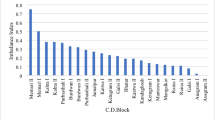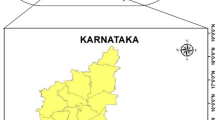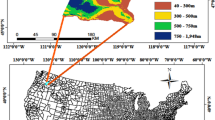Abstract
Soil salinization is one of the most frequent environmental concerns that contribute to the degradation of agricultural land, particularly in arid and semi-arid regions. The correct methods must be developed by farm owners and decision-makers in order to reduce soil erosion and increase crop output. For this, accurate spatial forecasting and soil salinity modeling in agricultural areas are needed. The accurate consideration of environmental elements under the scale effects, which have received less attention in prior research, is essential for digital soil mapping. The goal of this research is to create a special technique for predicting soil salinity. Preprocessing is done on the sentinel image input first. The next step is to determine the spectral channels, salinity index, and vegetation index. The development of transformation-based features also takes advantage of enhanced PCA. The suggested hybrid classifier uses "Deep Belief Network (DBN) and Bidirectional Long Short Term Memory (Bi-LSTM)" to predict salinity while accounting for these variables. The final forecast result is determined by the increased score level fusion. To improve the precision and accuracy of the prediction, Self Upgraded BSO (SU-BSO) calibrates the weights of the Bi-LSTM and DBN. The MSE values of the suggested technique are lower than those of other conventional methods like CNN, DBN, SVM, BI-LSTM, MLP-FFA, and MLSR metrics, achieving lower values of 0.13, 0.07, 0.03, 0.05, 0.09, and 0.094%, respectively. Finally, numerous measurements are employed to demonstrate the value of the selected approach.






Similar content being viewed by others
Data Availability
The data underlying this article are available in https://rrc.cvc.uab.es/?ch=3&com=downloads.
Abbreviations
- ANN:
-
Artificial Neural Networks
- BSO:
-
Beetle Swarm Optimization
- BWO:
-
Black Widow Optimization
- Bi-LSTM:
-
Bidirectional Long Short-Term Memory
- CM:
-
Cow Manure
- CNN:
-
Convolutional Neural Network
- DWT:
-
Discrete Wavelet Transform
- DNN:
-
Deep Neural Network
- DSM:
-
Digital Soil Mapping
- DNDC:
-
Denitrification Decomposition
- DA:
-
Dragonfly Algorithm
- DBN:
-
Deep Belief Network
- ELM :
-
Extreme Learning Machine
- EC:
-
Electrical Conductivity
- FF:
-
Firefly
- GRC:
-
Gravitational Reservoir Computing
- GSA:
-
Gravitational Search Algorithm
- GF:
-
Gaussian Filtering
- HBA:
-
Honey Badger Algorithm
- HC:
-
Hybrid Classifiers
- IWT:
-
Inverse Wavelet Transform
- LP:
-
Learning Percentage
- LST:
-
Land Surface Temperature
- MLSR:
-
Multiple Linear Stepwise Regression
- MAE:
-
Mean Absolute Error
- ML:
-
Machine Learning
- MLP-FFA:
-
Multilayer Perceptron—Firefly Algorithm
- MLP-NN:
-
Multilayer Perceptron Neural Networks
- NDVI:
-
Normalized Difference Vegetation Index
- ENS:
-
Nash-Sutcliffe Coefficient
- NDSI:
-
Normalized Difference Salinity Index
- RMSE:
-
Root Mean Square Error
- RF:
-
Random Forest
- PCA:
-
Principal Component Analysis
- PLS-SVM:
-
Partial Least-Squares-SVM
- RCELM:
-
Reservoir Computing ELM
- RVI:
-
Ratio Vegetation Index
- SVM:
-
Support Vector Machine
- SOM:
-
Soil Organic Matter
- SU-BSO:
-
Self Upgraded Bso
- SAVI:
-
Soil-Adjusted Vegetation Index
- TWI:
-
Topographic Wetness Index
- WFPS:
-
Water-Filled Pore Space
- WT:
-
Wavelet Transform
References
Imran M, Ashraf M, Awan AR (2021) Growth, yield and arsenic accumulation by wheat grown in a pressmud amended salt-affected soil irrigated with arsenic contaminated water. Ecotoxicol Env Saf 23 224(Cover date: November 2021):112692
Adil K, SalmanSaad E, AldulaimyYaareb M (2021) Abed, “Performance of soil moisture sensors in gypsiferous and salt-affected soils.” Biosyst Eng21 209(Cover date: September 2021):200–209
Pankaj U, Singh DN, Verma RK (2020) Autochthonous halotolerant plant growth-promoting rhizobacteria promote bacoside A yield of Bacopa monnieri (L.) Nash and phytoextraction of salt-affected soil. Pedosphere7 30(5 (Cover date: October 2020)):671–683
Emran M, Doni S, Gispert M (2020) Susceptible soil organic matter, SOM, fractions to agricultural management practices in salt-affected soils. Geoderma13 366(Cover date: 1 May 2020):114257
Nabiollahi K, Taghizadeh-Mehrjardi R, Scholten T (2020) Assessing agricultural salt-affected land using digital soil mapping and hybridized random forests. Geoderma16 385(Cover date: 1 March 2021):114858
Zhang L, Shao H, Qin X (2019) Effects of nitrogen and phosphorus on the production of carbon dioxide and nitrous oxide in salt-affected soils under different vegetation communities. Atmos Env22 204(Cover date: 1 May 2019):78–88
Xiao L, Jing Wei GY (2020) Soil properties and the growth of wheat (Triticum aestivum L.) and maize (Zea mays L.) in response to reed (phragmites communis) biochar use in a salt-affected soil in the Yellow River Delta. Agric Ecosyst Environ19 303(Cover date: 1 November 2020):107124
Ramdas G, Bappa M, Rahul D, Kulkarni M (2020) Monitoring properties of the salt-affected soils by multivariate analysis of the visible and near-infrared hyperspectral data. CATENA19 198(Cover date: March 2021):105041
Jia J, Bai J, Cui B (2020) Salt stress alters the short-term responses of nitrous oxide emissions to the nitrogen addition in salt-affected coastal soils. Sci The Total Environ17 742(Cover date: 10 November 2020):140124
Akhter N, Aqeel M, Noman A (2021) Foliar architecture and physio-biochemical plasticity determines survival of Typha domingensis pers. Ecotypes Nickel Salt Affect Soil Environ Pollut7 286(Cover date: 1 October 2021):117316
Barman A, Sheoran P, Kumar S (2021) Soil spatial variability characterization: Delineating index-based management zones in salt-affected agroecosystem of India. J Environ Manag13 296(Cover date: 15 October 2021):113243
Gupta BB, Yamaguchi S, Agrawal DP (2018) Advances in security and privacy of multimedia big data in mobile and cloud computing. Multimed Tools Appl 77:9203–9208
Gupta BB et al (2018) Advances in applying soft computing techniques for big data and cloud computing. Soft Comput 22:7679–7683
Andrade GRP, Furquim SAC, de Souza GC (2020) Transformation of clay minerals in salt-affected soils Pantanal wetland, Brazil. Geoderma 18(371):114380
Gharaibeh MA, Albalasmeh AA, El Hanandeh A (2021) Estimation of exchangeable sodium percentage from sodium adsorption ratio of salt-affected soils using traditional and dilution extracts, saturation percentage, electrical conductivity, and generalized regression neural networks. CATENA26 205(Cover date: October 2021):105466
Gunarathne V, Senadeera A, Gunarathne U et al (2020) Potential of biochar and organic amendments for reclamation of coastal acidic-salt affected soil. Biochar 2:107–120. https://doi.org/10.1007/s42773-020-00036-4
Zuo W, Bai Y, Lv M et al (2021) Sustained effects of one-time sewage sludge addition on rice yield and heavy metals accumulation in salt-affected mudflat soil. Environ Sci Pollut Res 28:7476–7490. https://doi.org/10.1007/s11356-020-11115-1
Mahajan G, Das B, Morajkar S et al (2020) Soil quality assessment of coastal salt-affected acid soils of India. Environ Sci Pollut Res 27:26221–26238. https://doi.org/10.1007/s11356-020-09010-w
Pankaj U, Singh DN, Singh G et al (2019) Microbial Inoculants Assisted Growth of Chrysopogonzizanioides Promotes Phytoremediation of Salt Affected Soil. Indian J Microbiol 59:137–146. https://doi.org/10.1007/s12088-018-00776-9
Dhaka VS et al (2021) A survey of deep convolutional neural networks applied for prediction of plant leaf diseases. Sensors 2114:4749
Wei Y, Ding J, Wang C (2020) Soil salinity prediction based on scale-dependent relationships with environmental variables by discrete wavelet transform in the Tarim Basin. CATENA6 196(Cover date: January 2021):104939
Xiao D, Huy Q, Ba V, Le T (2021) Salt content in saline-alkali soil detection using visible-near infrared spectroscopy and a 2D deep learning. Microchem J17 165(Cover date: June 2021):106182
Zhang Z, Ding J, Han L (2020) Strategies for the efficient estimation of soil organic matter in salt-affected soils through Vis-NIR spectroscopy: Optimal band combination algorithm and spectral degradation. Geoderma17 382(Cover date: 15 January 2021):114729
Li Z, Li Y, Xing A et al (2019) Spatial Prediction of Soil Salinity in a Semiarid Oasis: Environmental Sensitive Variable Selection and Model Comparison. Chin Geogr Sci 29:784–797. https://doi.org/10.1007/s11769-019-1071-x
Pouladi N, Jafarzadeh AA, Shahbazi F et al (2019) Design and implementation of a hybrid MLP-FFA model for soil salinity prediction. Environ Earth Sci 78:159. https://doi.org/10.1007/s12665-019-8159-6
Boudibi S, Sakaa B, Benguega Z et al (2021) Spatial prediction and modeling of soil salinity using simple cokriging, artificial neural networks, and support vector machines in El Outaya plain, Biskra, southeastern Algeria. Acta Geochim 40:390–408. https://doi.org/10.1007/s11631-020-00444-0
Hamid S, Shah H, Ben JW, Thomas W (2020) Modeling the effect of salt-affected soil on water balance fluxes and nitrous oxide emission using modified DNDC. J Environ Manag6 280(Cover date: 15 February 2021):111678
Thanh B, Nam N, Trinh N, Bach QV (2020) Methane emissions and associated microbial activities from paddy salt-affected soil as influenced by biochar and cow manure addition. Appl Soil Ecol13 152(Cover date: August 2020):103531
Taghadosi MM, Hasanlou M, Eftekhari K (2019) Retrieval of soil salinity from Sentinel-2 multispectral imagery. Eur J Remote Sens 52(1):138–154. https://doi.org/10.1080/22797254.2019.1571870
Xiaolong Z et al (2020) Improved itracker combined with bidirectional long short-term memory for 3D gaze estimation using appearance cues. Neurocomputing 390:217–225
Chen Q, Pan G (2020) A structure-self-organizing DBN for image recognition. Neural Comput Appl 33(3):877–886. https://doi.org/10.1007/s00521-020-05262-2
Wang T, Yang L, Liu Q (2020) Beetle swarm optimization algorithm: Theory and application. Filomat 34:5121–5137. https://doi.org/10.2298/FIL2015121W
Funding
This research did not receive any specific funding.
Author information
Authors and Affiliations
Contributions
All authors have made substantial contributions to conception and design, revising the manuscript, and the final approval of the version to be published. Also, all authors agreed to be accountable for all aspects of the work in ensuring that questions related to the accuracy or integrity of any part of the work are appropriately investigated and resolved.
Corresponding author
Ethics declarations
Conflict of Interest
The authors declare no conflict of interest.
Informed consent
Not Applicable.
Ethical approval
Not Applicable.
Additional information
Publisher's Note
Springer Nature remains neutral with regard to jurisdictional claims in published maps and institutional affiliations.
Rights and permissions
Springer Nature or its licensor (e.g. a society or other partner) holds exclusive rights to this article under a publishing agreement with the author(s) or other rightsholder(s); author self-archiving of the accepted manuscript version of this article is solely governed by the terms of such publishing agreement and applicable law.
About this article
Cite this article
Vijayalakshmi, V., Kumar, D.M., Kumar, S.C.P. et al. Soil salinity prediction based on hybrid classifier: study on Bellary and Chamarajanagar district in Karnataka. Multimed Tools Appl 83, 47225–47246 (2024). https://doi.org/10.1007/s11042-023-16652-8
Received:
Revised:
Accepted:
Published:
Issue Date:
DOI: https://doi.org/10.1007/s11042-023-16652-8




